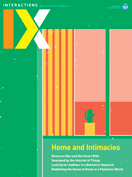Authors:
David Chatting
The Router of All Evil is a home WiFi router that I built to further my research through design investigation of a Network of One's Own (see http://davidchatting.com/nooo/). I view it as an exemplar of a pace layer prototype, intentionally designed to adapt and learn, able to respond to the environment in which it finds itself and to the researcher's emerging intentions, with a form and function that is thus pliable by necessity.
Stewart Brand describes pace layers as a way to disclose how complex systems operate at different paces [1], specifically as a way to understand durable civilizations. Previously, Brand identified six shearing layers in buildings, where each needs to be maintained for the building to endure and learn, from slow to fast: site, structure, skin, services, space plan, and stuff [2]. A building's site may be unchanged for hundreds of years, but its services (like plumbing) might be updated every few decades and the (typically small) stuff will be reconfigured through daily use. Similarly, complex technical systems can also be understood as layers. In his blog post "iPod and Adaptive Design" [3], Dan Hill describes, in Brand's terms, how after a firmware update he had "a whole new iPod," and yet the hardware (audio jack, control wheel, buttons, and screen) was unchanged.
Research products often seek to both endure daily life in the wild and be open to emergent opportunities [4,5]. To these ends, pace layer prototyping is a way to design layers of a prototype with different material (and immaterial) affordances to change, while maintaining a necessary degree of stability. Each layer requires different kinds of work and tools to make change, which can be manipulated by design.
The Router of All Evil is a commercial Linksys router that has been hacked open, then relaid out and made stable on an acrylic backplate. The design principally has two pliable layers: The pegboard at the top presents the possibility of changing the hardware of the router, where components and panels can be easily reconfigured physically, while the white acrylic area at the bottom is where software can be changed via digital interfaces. A Raspberry Pi intermediates between the hardware layer and the router via its GPIO (general-purpose input/output) pins. These are made accessible by way of a row of labeled binding posts that allow a semipermanent electrical connection to be made, without soldering. The router's firmware was replaced with OpenWrt, a popular Linux distribution that allows powerful configurations of the routing software. The Raspberry Pi was installed with Node-RED, a graphical programming environment that allows a variety of complex behaviors to be expressed and provides network interfaces like HTTP and MQTT. In this way, hardware and software layers are designed to be pliable to change.
Research products often seek to both endure daily life in the wild and be open to emergent opportunities.
As an example of how the Router of All Evil's layers configure change, an LED on the panel can be lit whenever the network contacts Google by creating a Node-RED flow that maps DNS activity to a GPIO pin, which is wired to an LED and rapidly given meaning with a simple handwritten label.
Pace layer prototype is drawn from my thesis work, undertaken with the guidance of Bill Gaver and Andy Boucher. This was supported by the Arts and Humanities Research Council (AHRC) Design Star Centre for Doctoral Training.
 | The Router of All Evil |
1. Brand, S. Pace layering: How complex systems learn and keep learning. Journal of Design and Science. 2018; https://doi.org/10.21428/7f2e5f08
2. Brand, S. How Buildings Learn: What Happens After They're Built. Penguin Books, 1995; https://doi.org/10.2307/990971
3. Hill, D. iPod and adaptive design. 2003; https://cityofsound.medium.com/the-ipod-and-adaptive-design-8889073e61a9
4. Gaver, W.W., Krogh, P.G., Boucher, A., and Chatting, D. Emergence as a feature of practice-based design research. Proc. of Designing Interactive Systems Conference. ACM, New York, 2022; https://doi.org/10.1145/3532106.3533524
5. Odom, W., Wakkary, R., Lim, Y-k, Desjardins, A., Hengeveld, B., and Banks, R. From research prototype to research product. Proc. of the 2016 CHI Conference on Human Factors in Computing Systems. ACM, New York, 2549–2561; https://doi.org/10.1145/2858036.2858447
David Chatting is a designer and technologist. He recently defended his thesis, "A Network of One's Own: Struggles to Domesticate the Internet," at Goldsmiths, University of London. He is currently at Newcastle University's Open Lab, engaged on the REAPPEAR project. [email protected]
Copyright held by author
The Digital Library is published by the Association for Computing Machinery. Copyright © 2023 ACM, Inc.








Post Comment
No Comments Found